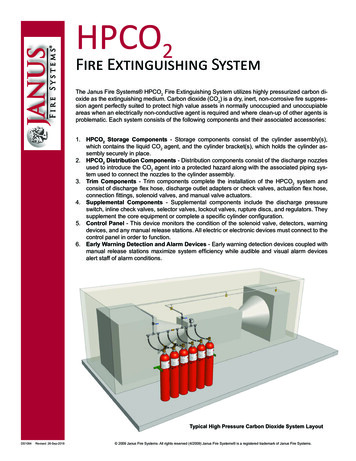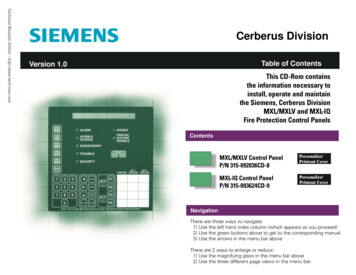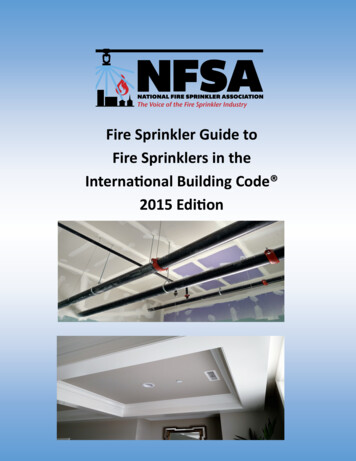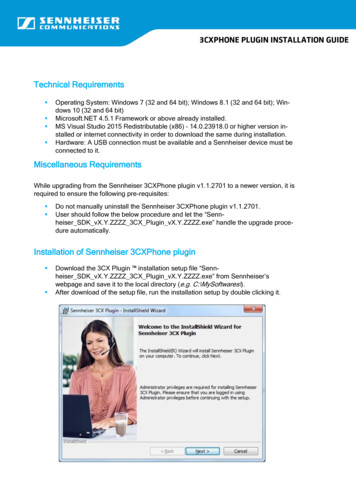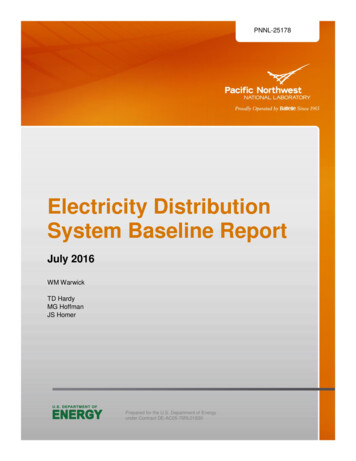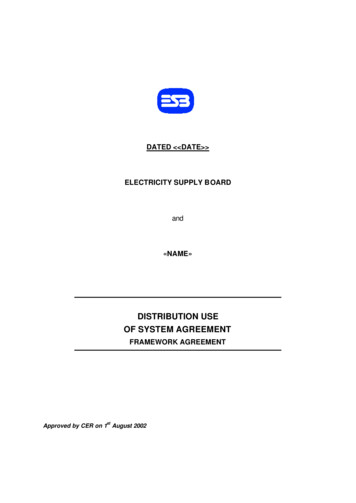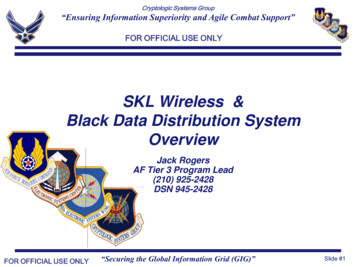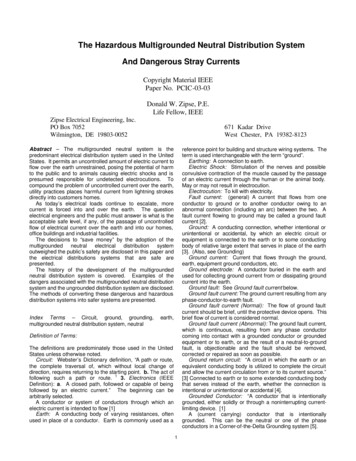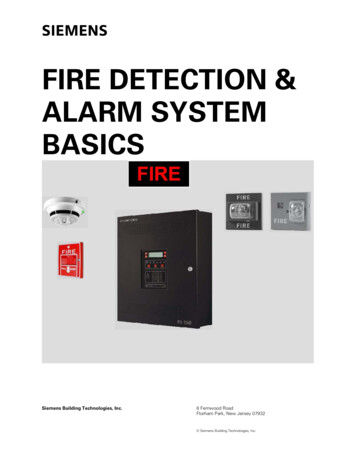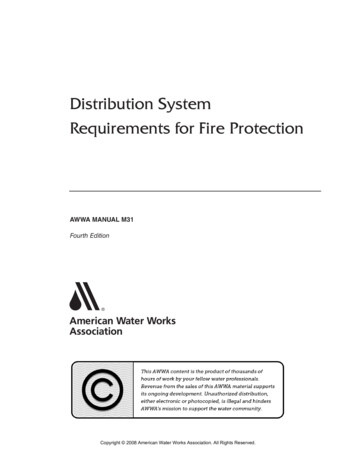
Transcription
Distribution SystemRequirements for Fire ProtectionAWWA MANUAL M31Fourth EditionCopyright 2008 American Water Works Association. All Rights Reserved.
ContentsList of Figures, vList of Tables, viiPreface, ixAcknowledgments, xiChapter 1 Fire Flow Requirements . . . . . . . . . . . . . . . . . . . . . . . . . . . . . . . . . . . 1Impact on Distribution System Design, 1Community Governance, 2Fire Flow Requirements, 2Calculating Fire Flow Requirements, 2Practical Limits on Fire Flow, 13Nonpotable Water Sources for Fire Fighting, 15References, 16Chapter 2System Demand and Design–Flow Criteria . . . . . . . . . . . . . . . . . 17Methods of Distribution, 17Rates of Water Use, 18Distribution System Appurtenances, 19System Evaluation and Design, 21Determining Design Flow, 21Flow Metering, 22Standby Charges for Fire Protection Systems, 22Water Distribution Analysis Techniques, 22References, 23Chapter 3Distribution System Storage. . . . . . . . . . . . . . . . . . . . . . . . . . . . . . . 25Functions of Distribution Storage, 25Elevated and Ground Storage, 27Pumping for Distribution Storage, 28Location of Storage, 28Storage Reservoir Overflow Level, 28References, 30Chapter 4 Adequacy and Reliability of Distribution Systems . . . . . . . . . . . 31Determining Level of Reliability, 31Application of Reliability Considerations, 33Reliability of Major System Components, 34Operations, 36References, 37iiiCopyright 2008 American Water Works Association. All Rights Reserved.
Chapter 5 Automatic Fire Sprinkler Systems . . . . . . . . . . . . . . . . . . . . . . . . . 39Advantages of Sprinkler Systems, 39Water Supply Requirements for Sprinklered Properties, 40Types of Sprinklers for Commercial Buildings, 42Standpipes, 43Backflow Prevention for Fire Sprinkler Systems, 43References, 45Appendix A Agencies Involved in Fire Protection . . . . . . . . . . . . . . . . . . . . . 47Insurance Services Office Inc., 47Insurance Organizations With Fire Protection Interests, 48National Fire Protection Association, 48National Fire Service Associations, 48Fire Research Laboratories, 48National Fire Sprinkler Association, 48American Fire Sprinkler Association, 49International Code Council, 49Insurance Bureau of Canada, 49Insurers’ Advisory Organization, 49National Research Council, 49Underwriters Laboratories of Canada, 49Appendix B Water Supply and Fire Insurance Ratings. . . . . . . . . . . . . . . . . 51Insurance Ratings, 51References, 54Index . . . . . . . . . . . . . . . . . . . . . . . . . . . . . . . . . . . . . . . . . . . . . . . . . . . . . . . . . . . . . . 55List of AWWA Manuals. . . . . . . . . . . . . . . . . . . . . . . . . . . . . . . . . . . . . . . . . . . . . . . 59ivCopyright 2008 American Water Works Association. All Rights Reserved.
AWWA MANUALChapterM311Fire Flow RequirementsFor centuries, water has been used to extinguish fires. The inexpensiveness andavailability of water are the primary factors leading to its widespread use. But, notonly must water be available for fire protection, it must be available in adequatesupply. As a result, the question must be asked, how much water is necessary to beconsidered an adequate supply for fire protection? (Milke 1980)Most municipalities are willing to incur the higher cost for distribution systemsizing because of the reduction in loss that is possible by using the water system for fireprotection. Water in sufficient quantity can cool the fire; the steam can deprive the fireof oxygen, and in the case of miscible or dense fluids, water can disperse the fuel. Thekey question for water utilities is how large must distribution system components beto provide sufficient water for fire protection. The remainder of this manual presentsmethods for estimating these requirements.IMPACT ON DISTRIBUTION SYSTEM DESIGN The decision to provide water for fire protection means that a utility must explicitlyconsider fire flow requirements in sizing pipes, pumps, and storage tanks. In largersystems, fire protection has a marginal effect on sizing decisions, but in smaller systems these requirements can correspond to a significant increase in the size of manycompo nents. In general, the impact of providing water for fire protection ranges frombeing minimal in large components of major urban systems to being very significant insmaller distribution system pipes and small distribution systems.The most significant impacts are installing and maintaining fire hydrants, providing adequate storage capacity, and meeting requirements for minimum pipe sizes(e.g., 6-in. [150-mm] pipes in loops and 8-in. [200-mm] dead ends) in neighborhooddistribution mains when much smaller pipes would suffice for delivery of potable wateronly. These requirements make designing distribution systems easier for the engineerbut more costly for the water utility. Other impacts include providing extra treatmentcapacity at plants and extra pumping capacity at pump stations.1Copyright 2008 American Water Works Association. All Rights Reserved.
2Fire protectionCOMMUNITY GOVERNANCE The decision of whether or not to size distribution system components, including waterlines, appurtenances, and storage facilities, for fire protection must be made by thegoverning body of the community. This decision is made in conjunction with the waterutility if the utility is privately owned. However, there is no legal requirement that agoverning body must size its water distribution system to provide fire protection. Insome instances, this undertaking may be prohibitively expensive. For privately ownedutilities, the distribution system would not be sized for fire protection unless such anundertaking could be shown to be commercially profitable.The governing bodies of most communities do provide water for fire protectionfor a variety of reasons, including protection of the tax base from destruction by fire,preservation of jobs that would be lost in the event of a large fire, preservation of human life, and reduction of human suffering.When a community’s governing body provides fire protection, it must do so inaccordance with a well-thought-out plan that will provide adequate supplies for the intended purpose. An inadequate fire protection system provides a false sense of securityand is potentially more dangerous than no system at all.FIRE FLOW REQUIREMENTS When establishing a fire protection plan, the governing body must first select a welldocumented procedure for determining the fire flow requirement. Central to providing “enough” water is a determination of how much water should be made availablefor any given situation. The following definition of required fire flow will be used inthis manual: the rate of water flow, at a residual pressure of 20 psi (138 kPa) and fora specified duration, that is necessary to control a major fire in a specific structure.A complete definition of required fire flow requires a determination of both the rateof flow required and the total amount of water that must be applied to control thefire. The rate of flow and the duration of flow required may be specified by the simple equation:quantity rate duration(Eq. 1-1)Understanding Water UseThe importance of flow rate and total quantity must be realized when attempting tounderstand the ways in which water is used to suppress fire. Water applied to a fire accomplishes two things. First, it removes the heat produced by the fire, thereby preventing that heat from raising the temperature of unignited material to the ignition point.Water absorbs the heat of the fire when it changes from a liquid to a gaseous state asthe heat is released as steam. Second, water not converted to steam by the heat of thefire is available to cool material not yet ignited. Water also blankets unignited material, excluding the oxygen required to initiate and sustain combustion.CALCULATING FIRE FLOW REQUIREMENTS All fires are basically different because of random variations in the structure andcon tents of the burning building, exposures (configuration of adjacent structures notinvolved in a fire but that are to be protected to prevent the fire from spreading),weather, temperature, and length of time the fire has been burning. Consequently,numerous methods have been proposed for determining how much water is enough tosuppress a fire. The following sections describe four methods for calculating fire flowrequirements. These methods have been developed by the Insurance Services OfficeCopyright 2008 American Water Works Association. All Rights Reserved.
fire flow requIrements 3Table 1-1 Fire flow durationsRequired Fire FlowDurationgpm(L/sec)hr2,500 or less(158 or less)23,000 to 3,500(189 to 221)3Inc. (ISO),* Iowa State University (ISU),† the National Fire Academy,‡ and the IllinoisInstitute of Technology Research Institute (IITRI).§Responsibility for determining needed fire flows for individual structures usuallyrests with the local fire officials based on information provided by the owner. Rating services such as ISO may determine this flow during an evaluation for insurance pur poses. For planning purposes, water departments may determine representative fireflow requirements in portions of towns for system planning, hydraulic analysis, anddesign.Flow DurationsRecommended fire flow durations¶ to be used in the four methods are given in Table 1-1.The maximum required fire flow for a single fire event is 12,000 gpm (757 L/sec).Insurance Services Office MethodThe ISO’s technique for calculating required fire flow is documented in its publica tionFire Suppression Rating Schedule. The term used in that document to describe the fireflow requirement is needed fire flow (NFF).Needed fire flow (NFF). The NFF is the rate of flow considered necessary tocontrol a major fire in a specific building for a certain duration. It is intended to assess the adequacy of a water system as one element of an insurance rating schedule.It is not intended to be a design criterion. However, it has been demonstrated that theNFF reasonably coincides with the actual flow required to suppress a fire in a real-life situation.A water supply should be capable of providing the maximum NFF within its distribution system area. In designing a new water distribution system or improvementswithin an existing distribution system, it is customary to provide for the NFF withinthe design area. However, it is very unusual for an existing water distribution systemto be capable of providing every NFF within its service area.The ISO classification of a community’s water system is based on the availablerates of flow at representative locations, with an NFF of 3,500 gpm (221 L/sec), or less,as determined by the application of its Fire Suppression Rating Schedule. Private andpublic protection at properties with larger NFFs is individually evaluated and mayvary from the community’s classification.* Insurance Services Office Inc., 545 Washington Blvd., Jersey City, NJ 07310-1686.† Iowa State University, Fire Extension Service, Ames, IA 50011.‡ US Fire Administration, 16825 S. Seton Ave., Emmitsburg, MD 21727.§ Illinois Institute of Technology Research Institute, 10 W. 35th St., Chicago, IL 60616.¶ Fire flow durations are based on the 19th edition of the National Fire Protection Association’s Fire Protection Handbook, table 10.4.6.Copyright 2008 American Water Works Association. All Rights Reserved.
4Fire protectionTable 1-2Values of coefficient (F ) construction classClassCoefficientClass 1Frame1.5Class 2Joisted Masonry1.0Class 3Noncombustible0.8Class 4Construction (masonry, noncombustible)0.8Class 5Modified fire resistive0.6Class 6Fire resistive0.6Calculation. The calculation of an NFF, in gallons per minute (gpm), for a subject building, considers the construction (Ci), occupancy (Oi), exposure (Xi), and communication (Pi) factors of that building, or fire division, as outlined here.Construction factor (Ci). That portion of the NFF attributed to the type of construction and area in square feet of the subject building is determined by the followingformula*:Ci 18F (Ai)0.5(Eq. 1-2)Where:F coefficient related to the class of construction (see Table 1-2)Ai effective areaEffective area (Ai). This is the total area in square-feet of the largest floor† in thebuilding plus the following percentage of the other floors: for buildings of construction class 1–4, 50 percent of all other floors; for buildings of construction classes 5 or 6, if all vertical openings in thebuilding have 1.0 hr or more protection, 25 percent of the area not exceeding the two largest floors‡. The doors shall be automatic or self-closing andlabeled as class B fire doors (1.0 hr or more protection). In other buildings, 50percent of the area not exceeding eight floors.§* Reprinted with permission—Insurance Services Office Inc., 2006. Copyright ISO PropertiesInc., 2001, 2006.† If division walls are rated at one hour or more with labeled class B fire doors on openings,they subdivide a floor. The maximum area on any one floor used shall be the largest undivided area plus 50 percent of the second largest undivided area on that floor. NOTE: Do notinclude basement and subbasement areas that are vacant, that are used for building maintenance, or that are occupied by C-1 or C-2 occupancies (see Table 1-3).‡ Reprinted with permission—Insurance Services Office Inc., 2006. Copyright ISO PropertiesInc., 2001, 2006.§ Reprinted with permission—Insurance Services Office Inc., 2006. Copyright ISO PropertiesInc., 2001, 2006.Copyright 2008 American Water Works Association. All Rights Reserved.
fire flow requIrements 5Table 1-3 Occupancy factors for selected combustibility classesCombustibility ClassOccupancy Factor (Oi)C-1Noncombustible0.75C-2Limited combustible0.85C-3Combustible1.00C-4Free burning1.15C-5Rapid burning1.25The maximum value of Ci is limited by the following: 8,000 gpm (505 L/sec) forconstruction classes 1 and 2; 6,000 gpm (378 L/sec) for construction classes 3, 4, 5,and 6; and 6,000 gpm (378 L/sec) for a one-story building of any class of construction.The minimum value of Ci is 500 gpm (32 L/sec). The calculated value of Ci should berounded to the nearest 250 gpm (16 L/sec).Occupancy factor (Oi). The occupancy factors, given in Table 1-3, reflect the influence of the occupancy in the subject building on the NFF. Representative lists of occupancies by combustibility class are given in Figures 1-1 and 1-2.Exposures (Xi) and communication (Pi) factors. The exposures and communication factors reflect the influence of exposed and communicating buildings on the NFF.A value for (Xi Pi) shall be developed for each side of the subject building as shownin Eq 1-3:n( X P ) i 1 .0 Where: (X P)i 1iimaximum 1.60(Eq. 1-3)n number of sides of subject buildingThe factor for Xi (exposure) depends on the construction and length–height value(length of wall in feet times height in stories) of the exposed building and the distancebetween facing walls of the subject building and the exposed building. This factor shallbe selected from Table 1-4. When more than one exposure side exists for the subjectbuilding, apply only the largest factor Xi for that side. When there is no exposure on aside, Xi 0.The factor for Pi (communications) depends on the protection for communicatingparty wall openings and the length and construction of communications between firedivisions. This factor shall be selected from Table 1-5. When more than one communication type exists in any one side wall, apply only the largest factor Pi for that side.When there is no communication on a side, Pi 0.Needed fire flow. The calculation for NFF isNFF (Ci)(Oi)[1.0 (X P)i ](Eq. 1-4)When a wood shingle roof covering on a building or on exposed buildings can contribute to spreading fires, add 500 gpm (32 L/sec) to the NFF. The NFF shall not exceed12,000 gpm (757 L/sec) or be less than 500 gpm (32 L/sec). The NFF shall be roundedto the nearest 250 gpm (16 L/sec), if less than 2,500 gpm (158 L/sec), and to the nearest500 gpm, if greater than 2,500 gpm.Copyright 2008 American Water Works Association. All Rights Reserved.
6Fire protectionClassification 1Steel or concrete products storage, unpackagedClassification HotelsMotelsOfficesParking garagesSchoolsClassification 3Amusement park buildings, including arcades and game roomsAutomobile sales and serviceDiscount storesFood and beverage—sales, service, or storageGeneral merchandise—sales or storageHardware, including electrical fixtures and suppliesMotion picture theatersPharmaceutical retail sales and storageRepair or service shopsSupermarketsUnoccupied buildingsClassification 4Aircraft hangars, with or without servicing/repairAuditoriumsBuilding material sales and storageFreight depots, terminalsFurniture—new or secondhandPaper and paper product sales and storagePrinting shops and allied industriesTheaters, other than motion pictureWarehousesWood product sales and storageClassification 5Chemical sales and storageCleaning and dyeing material sales and storagePaint sales and storagePlastic or plastic product sales and storageRag sales and storageUpholstering shopsWaste and reclaimed material sales and storageFigure 1-1Typical occupancy classifications—nonmanufacturingFor one- and two-family dwellings not exceeding two stories in height, the NFFlisted in Table 1-6 shall be used. For other habitable buildings not listed in Table 1-6,the NFF should be 3,500 gpm (221 L/sec) maximum. For a building protected by automatic sprinklers, the NFF is that needed for the sprinkler system, plus hose streamsconverted to 20 psi (138 kPa) residual pressure, with a minimum of 500 gpm. See theNational Fire Protection Association Standard No. 13 (13D or 13R) for the water requirements at the base of riser for sprinklers.Copyright 2008 American Water Works Association. All Rights Reserved.
fire flow requIrements 7Classification 2Ceramics manufacturingConcrete or cinder products manufacturingFabrication of metal productsPrimary metals industriesClassification 3Banking and confectionaryDairy processingLeather processingSoft drink bottlingTobacco processingClassification 4Apparel manufacturingBreweriesCotton ginsFood processingMetal coating or finishingPaper products manufacturingRubber products manufacturingWoodworking industriesClassification 5Cereal or flour millsChemical manufacturingDistilleriesFabrication of textile products, except wearing apparelMeat or poultry processingPlastic products manufacturingTextile manufacturingFigure 1-2Typical occupancy classifications—manufacturingIowa State University MethodResearch conducted at the Fire Extension Service at ISU resulted in the development ofa rate of flow formula. This formula addresses, in some detail, both the quantity of waterrequired to extinguish a fire and the effects of various application rates and techniques.The formula is referenced in ISU Bulletin 18. The ISU method of determining requiredfire flows is the oldest method discussed in this manual. It was first published in 1967.The ISU technique referenced several Danish studies for its theoretical and statistical bases. In addition, several experiments were performed, including actual fires insmall rooms. The resulting equation for computation of [needed] fire flow, G, according to this technique is:G* volume of space (in cubic feet) 100* F ire flow G in this excerpt is synonymous with needed fire flow (NFF) referenced throughoutthis manual.Copyright 2008 American Water Works Association. All Rights Reserved.
8Fire protectionTable 1-4 Factor for exposure (Xi)Construction of Facing Wall of Exposed BuildingConstruction Classes1, 3Construct
labeled as class B fire doors (1.0 hr or more protection). In other buildings, 50 percent of the area not exceeding eight floors.§ Table 1-2 Values of coefficient (F) construction class Class Coefficient Class 1 Frame 1.5 Class 2 Joisted Masonry 1.0 Class 3 Noncombustible 0.8 Class 4
